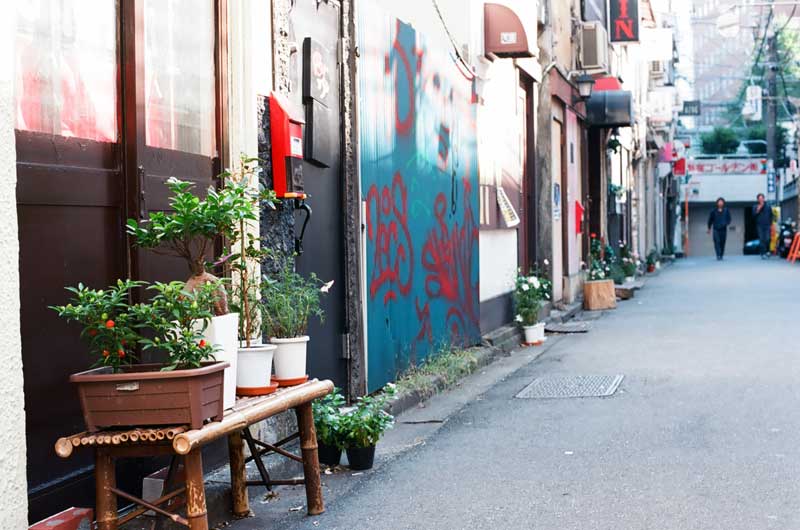
Small potted plants on bamboo bench in Golden Gai



荷造りひもがこの大きな木を支えているのでしょうか? 東京に旧道の名残りがあります。
Do you think this twine can stabilize such a massive tree? Traces of an old country road in Tokyo.
Parallel to many elevated expressways and train lines are the vestiges of old country roads, some of which date back to Edo times. On last month’s @ArchitourTokyo bike tour of Suginami (and bordering areas), Linus Yng took me on some roads where you can sense the past and how the city has changed. This road is at once very wide and sparsely used. Another indication of the street’s age is the wonderful old tree whose canopy extends to the other side of the street.

I love the two recent additions to this tree: a bench provided by a neighbor, and the plastic twine around the trunk. Do you think this twine can stabilize such a massive tree?
The Japan Times published an interesting story about the lack of benches on Tokyo’s streets. From the official government and planning perspective, streets are for moving traffic and pedestrians. The idea of city streets as a community space is not a factor.
I am always struck by how retrograde city planning is in Tokyo. As an architect professor friend told me, Tokyo’s many narrow, single-grade small streets-which are now considered the “new” thing in the US and Europe for promoting walking and biking-are undoubtedly considered shameful relics by the city’s traffic planners, whose mission is to move auto traffic as rapidly as possible.
The most innovative ideas for using streets as community life seem to come from residents (see my previous posts about residents supplying their own bus stop seating), and from real estate corporations that own enough Tokyo land to motivate them to create unique and livable streets. I thought of the latter last week seeing the many public benches in the Marunouchi district’s wide, tree-lined streets. The district is largely owned by Mitsubishi Real Estate.
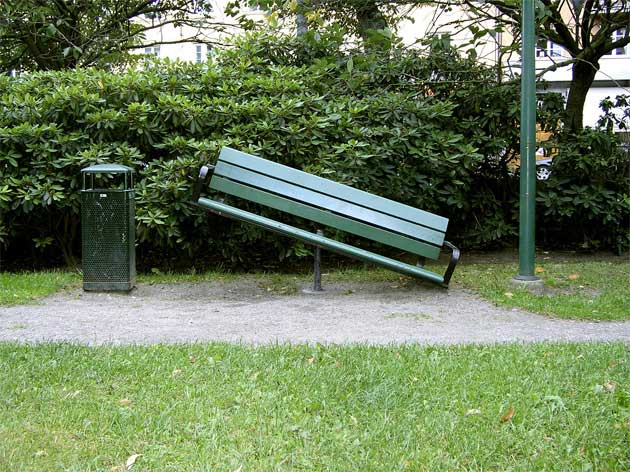
A sad story from San Francisco about a merchant group opposing the redesign of a historic public space leading to a central transit station because it will include benches. Equally disheartening is that some of the plans call for reducing the amount of plants and planter boxes. The fear of homelessness and vandalism is a great challenge to creating livable and enjoyable public spaces in the US and Europe, and affects both civic and grassroots urban improvements. Sad.
(Image of Martin Nicolausson seesaw bench, designed to require cooperation between strangers and to generate conversation, via The Fire Wire blog).

This old sign for a shoe shop, offering repair and shoe-making, adds to the neighborly feel of Zoushigaya and the sense of long-time residents and small businesses.
More uncanny was this strange pop-up park in an empty lot. It looks new, and includes two new benches, a shed, a fake well (there’s a faucet behind the facade), three fresh ikebana flower displays, wood and stone paths, and two water wheels. Who created this new park? I was amazed to peek behind the shed and see garden supplies and tools that had not been stolen or vandalized.

The enormous raphis palms growing outside the home below suggest decades of growth. I wonder if the person who planted it ever expected it to get so huge?

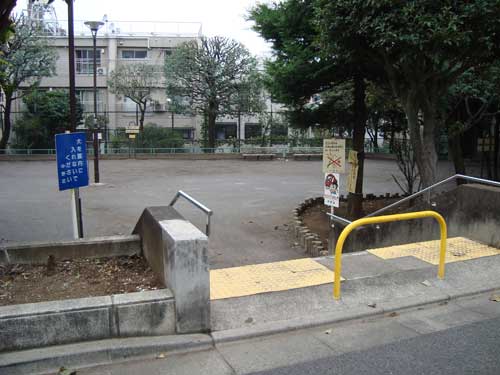
I am struck by how poorly maintained and under-used many of the residential neighborhood parks are. This one, close to where I live, is large, has many mature trees facing the street, and has almost no usage. To call it uninviting and unloved would be an understatement.
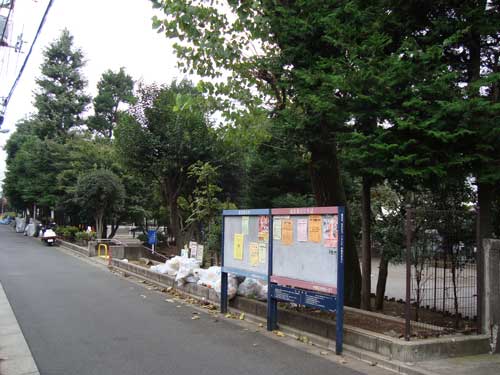
The street side is almost promising. There is a long row of mature trees and a community bulletin board. Next to the bulletin board, and also on the far end of the park, are designated areas to leave your trash. Unfortunately, there is no receptacle for the bagged garbage, so crows and cats pick through the bags and the contents start to disperse.
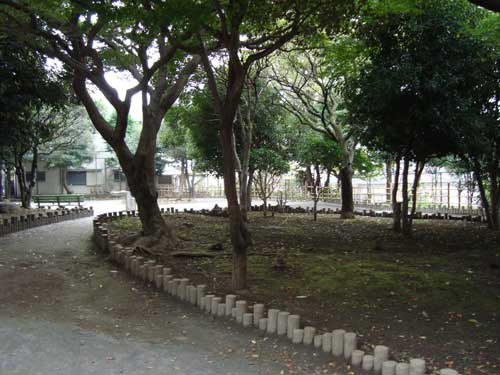
The entrance to the park reveals vast areas of gravel, unplanted beds, and few amenities or attractions. The size of the park only underscores the waste of so much public space going unused. Given how avidly neighbors tend to their tiny gardens and occupy small strips of public space, why are local governments unable to harness this human resource for beautifying and maintaining public space?
I can imagine many other uses for the park: community vegetable gardens, flower contests, rice field, bee hives, food stand, children’s play area, public art-making space. Given limits to local government budgets, maybe there would be a way to attract corporate sponsors and neighborhood volunteers. If more people were attracted to enter the park, I am sure it would be cleaner and more inviting.
After the jump is a photo inventory of the current park assets, mostly aging structures with a surprising amount of trash. During my visit I noticed a small garden crew and two people on a bench.

Tokyo Green Space celebrates the ingenuity of people who create greenery in a city that is often poorly planned, dominated by concrete, and overly paved. However, it is worth pointing out the prevalence of dead spaces by design, often created by local governments and even Tokyo Metro.
Above is a nearly brand new elevator providing access to the Shin Nakano Marunouchi station of Tokyo Metro. The elevator occupies an odd shaped and small space between a road and parking lot, and between a pachinko parlor, a large apartment building and a busy street. Next to the rectilinear elevator and covered entrance is a sizeable triangular area bordered by a brown colored metal fence.
Clearly, the Metro does not want people to park their bikes in this small area, and is probably pleased that they have accomplished this goal. However, the fence has made this centrally located land a dead zone. So many other uses could be made with that space: a tree or two, a bench, a vegetable garden, a food cart, newspaper stand, a bulletin board for community events. Given the amount of local gardeners, I am certain that the Metro would not need to maintain the space with their own staff.

A similar dead triangle zone was created between a pedestrian path and a small street. Again, the design goal is to prevent vehicles from entering the pedestrian path (in the foreground with white tiles on the ground). Here, too, the brown metal fence creates a triangle of deadness, where the yellow and green poles would have seemed adequate for the job.
If the brown metal fence was not there, the space could also be used for much needed shade, a fruit tree, a community garden, or a bench. The creation of these dead spaces by government authorities suggests a lack of imagination and awareness.
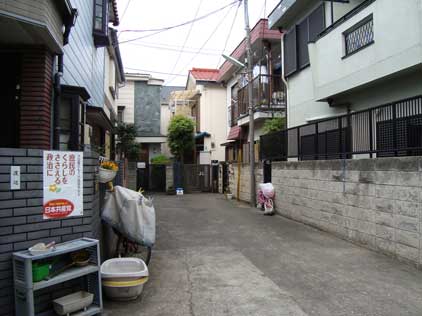
Finally, this space between houses and apartments is filled with concrete, and apparently unused. It is unclear whether the space is public street, individually owned or somehow shared space between neighbors. In any case, it is a wasted opportunity for greenery and community.
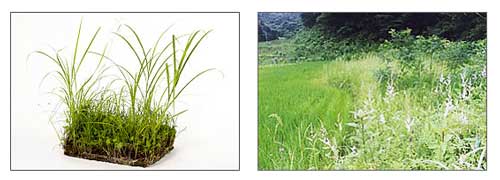 In an earlier post, I talked a little about 5bai Midori‘s street beautification products and the creative force behind this small green business Tase Michio. This post uses photos from their website to explore their idea of restoring the countryside, or satoyama(里山), and bringing it into the city.
In an earlier post, I talked a little about 5bai Midori‘s street beautification products and the creative force behind this small green business Tase Michio. This post uses photos from their website to explore their idea of restoring the countryside, or satoyama(里山), and bringing it into the city.
The photos above illustrate the concept of carving a piece of rural nature into a modular square. 5bai Midori plants these bio-diversity trays on modular metal cubes with up to five sides for plants and special light-weight soil. Applications include residential entrances, sidewalks and balconies, apartment and office buildings, green walls, rooftops, neighborhood planters, boulevard and highway guard rails, interiors, benches, and special events. They have targeted individuals, governments (including amazing, yet unrealized plans for greening Kabukicho and Marunouchi), developers and construction companies.
These are some images of how plant trays are cultivated to include a multitude of species in a small area.
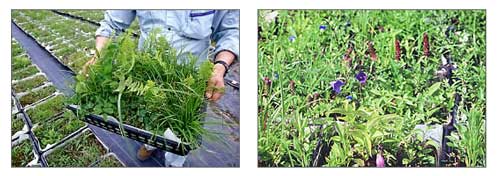
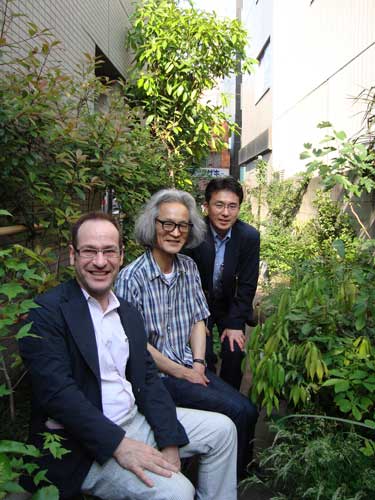
This week I had the amazing opportunity to meet one of my landscape design heroes, Tase Michio (田瀬理夫) of Plamtago. He has created urban architecture and a green business that bring native plants and habitats to urban areas. His most famous work is the 1995 Acros Fukuoka building, a 15 story lush hillside on top of a downtown office building. More recently, he provided the creative direction for 5bai Midori, a Tokyo company that brings “satoyama” (里山) or a slice of rural Japan into urban areas through a modular 5-sided system.
With a shock of grey hair, Tase sensei is patient with visitors, provocative and without pretense. Born 60 years ago in Ichigaya, Tokyo, not far from his current Plamtago home office, Tase says he has been monitoring the natural environment of Tokyo since his childhood. His view is that urban land use is worse today than in the 1970s. And despite the success of Acros Fukuoka, which looks fuller and more wild after 14 years of growth, Tase is disappointed that there have been no other high rises incorporating bio-diversity into their architecture.

Tase describes his work as “Passive Architecture & Active Landscape with Nature.” For cities, he aims to increase the number of plant species, slow rainfall and filter it before it reaches rivers and bays, create healthy wildlife habitats, and improve the soil. I was struck that he sees as urban eco-system indicators tiny ticks, which reflect good soil and perhaps small animals, and also hawks. Ticks and at least one hawk reside in the forest of Tokyo’s Imperial Palace.